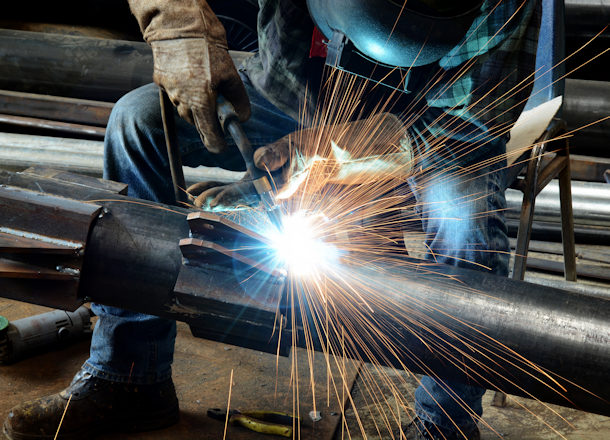Welding doesn’t require an expensive college degree, it has a growth rate of 6 percent and it pays $20 per hour or more in most places. It’s easy to see why people are jumping into the trade in droves. But before you start taking on weekend projects or consider becoming a full-time welding warrior, consider the type of equipment you’ll need on hand to start off with.
Safety Equipment First
Welding is a dangerous job that requires you to be around high heat, fumes, sparks and other debris that threaten your health if you don’t use the proper safety equipment. Taking on a welding job requires a helmet, gloves, glasses and a respirator.
An auto-dimming welding helmet senses when bright light emerges and quickly dims the shield. In addition to protecting your eyes from unnecessary light, the helmet makes it easier for welders to find their weld joint easily when the shield is down.
Gloves and safety glasses are just as important as the helmet. Because melting metal requires very high temperatures, you must have gloves that can withstand the heat and the UV rays required to perform the task. Quality welding gloves are made of leather and cover your hands and arms up to your elbow. The gloves you purchase may vary slightly depending upon the type of welding you expect to be doing.
Next, you’ll need a pair of safety glasses to protect you from any runaway sparks that fly under your helmet’s shield. Look for something that covers your eye all the way around instead of simply settling on the bridge of your nose.
Platforms to Perform Your Work
A sturdy workbench or cart is necessary to hold your welding machine. A solid metal workbench makes it easy for you to perform tasks safely and in a position that eases the strain on your back. There are a range of benches already on the market, but if you can’t find something that specifically meets your needs or preferred style, you can also commission a custom bench or even build your own.
Many welders find they need to move their welding tools from place to place, making portability a requirement. A rolling welding cart allows you to move your welding machine and essential supplies from one job to the next with minimal hassle.
Welding Machines to Meet Your Needs
Of course, purchasing welding equipment is ridiculous without a welding machine. The most common machines are MIG, TIG or stick machines, each with its own advantages and disadvantages. MIG welding machines have a wire-welding electrode that automatically feeds through at a pre-selected and constant speed.
This type of machine is clean and easy and best used for thin or thick plate metals. TIG welding machines use non-consumable tungsten electrodes. A shielding gas like argon protects the weld from atmospheric contamination. TIG welding is common for thin pieces of stainless steel, alloy steel or nonferrous metals like aluminum.
Finally, stick welding machines are most common in home shops. This type of machine uses an electric current that flows through a gap between the welding rod and the metal. It is effective for most alloys and is useful both indoors and outdoors. Determine the type of welding you intend to do before deciding which type of machine to buy.
Other Types of Welding Equipment
After purchasing the machine, safety equipment and platform, determine whether you need accessories. A variety of them exist.
• Angle Grinder: An angle grinder allows you to perform a range of tasks, including cleaning the welding joint, smoothing welds and cutting metal.
• Hammer and Dolly Kit: These kits allow you to straighten panels or fine-tune joints as you weld.
• Pre- and Post-Weld Treatments: Treatments allow you to clean your weld surfaces before and after welding, which protects them from corrosion.
• Welding Clamps: Welding clamps keep your pieces firmly together while you complete the welding process. This is helpful for creating tight joints and working on larger pieces. Clamps are available in a variety of shapes and sizes.
• Copper Backing Plates: Copper plates help you to back up gaps in your weld joints. They’re also helpful for beginners who may burn through thin gauge metals.
• Measuring Tools: Never eyeball work when you’re welding. Purchase tape measures, rulers, calipers, T-squares and everything else you need to ensure an accurate weld.
When it comes to purchasing your equipment, make smart choices and remember that you get what you pay for. While the most expensive equipment often has bells and whistles you won’t need as a beginner, the cheapest pieces may be faulty or simply cheaply made. If you purchase new equipment, aim for middle-ground prices.
You might also consider purchasing gently used equipment at more affordable prices. Regardless of where you buy your welding machine and accessories, perform a thorough inspection before beginning a job.


